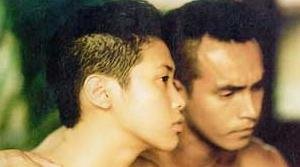
Dang Bireley and the Young Gangsters (Nonzee Nimibutr, 1997)
Thai Title: 2499 antapan krong muang
Nonzee Nimibutr's debut feature film Dang Bireley and the Young Gangsters is probably the influential Thai director's best film. Nimibutr's usual faults, his haphazard style of storytelling, his overly emphasized sense of cultural mood and atmosphere, his incomprehensible editing style, are at an all-time low here. The film, while good, is not exactly a brilliant piece of filmmaking. It lacks subtlety, but it does effectively evoke the chaotic discord of 50's Bangkok where social and political unrest reflects in the city's youth's lack of direction.
Dang Bireley (Jesdaporn Pholdee) killed his first man when he was thirteen, while trying to defend his mother, a street prostitute. Growing up, he mixed with the wrong crowd and inevitably formed a gang with his friends, Lam (Noppachai Muttaweevong), mercurial Pu Bottlebomb (Supakorn Kitsuwon) and his trusty lapdog Dum. Dang's best pal is Piak (Attaporn Teemakorn), the son of a Buddhist monk. He tries his best to keep Piak from joining his gang, even to the point of lending him money for his schooling, but after Piak middled in a gang war between Pu and his college friends, he is expelled from college, and breaks up Dang's friendship with Pu, causing a lifelong rift between the two.
Dang Bireley is an actual gangster who lived in Bangkok in the 50's. The film is told from the point of view of an middle-aged Piak who narrates the tale while reminiscing his youthful days. Dang Bireley's idol is James Dean and his life basically mirrors that of the Hollywood bad boy. Dean died in a car accident, and Dang dies the same way, of course, after figuring himself in a couple of adventures, which is the bulk of Nimibutr's film. Nimibutr recreates 50's Bangkok with unassuming ease, using costumes, settings, props and music that effectively capture the decade.
The film is beautifully photographed, further emphasizing the colorfully exciting era. Nimibutr doesn't plunge the film within Thailand's political landscape and centers mainly on the lives of the young gangsters. Whatever notion of social unrest is told from Piak's remorseful narration, and from there, we get a sense of what's really happening in the grander scale. Nimibutr's intimate portrait of the Thai youth is actually quite engaging. Although Nimibutr tends to direct overbearingly, using different lens, or slow motion, in different levels of success, the film still comes off as surprisingly coherent, and the characters, although psychologically simple, don't make decisions based on karma or fate, which is usually my complaint over Nimibutr's film characters who tend to do things not out of logic, but out of principles that may be foreign to non-Buddhists.
Dang Bireley and the Young Gangsters is violent. There's no constraint in depicting bloody battles, which range from alleyway rumbles consisting of student fighting it out with lead pipes and chains, to street wars where bullets fly and bottle bombs explode. Nimibutr's filmmaking reenacts the mindless wanton, the unrepressed angst that pervades Thailand's youth who take American pop culture much too seriously. It is as if these young gangsters do not really see the need to become gangsters, but out of trying to emulate their idols, gravitate towards the overhyped myths of these rock and roll and celluloid legends. I doubt James Dean and Elvis Presley will figure themselves in these youth wars that involve actual deaths and somewhat politically motivated attacks, but the tall tales surrounding their personalities provide inspiration for wrongly-placed notions of righteousness and blank bravery for the youth who circumstantially find themselves in a troubled era of political and social confusion.








wm_p1.jpg)


























